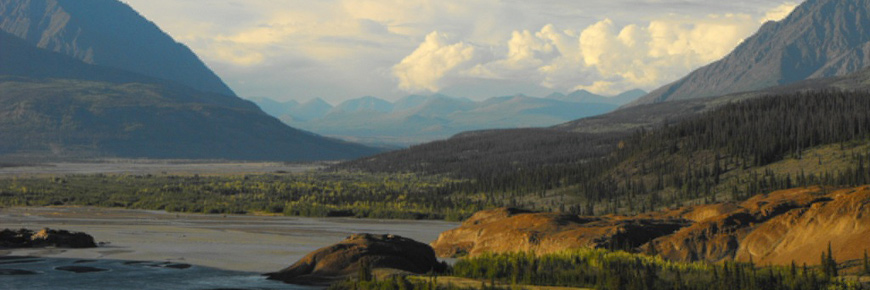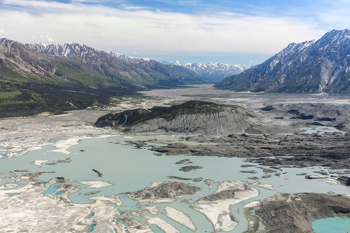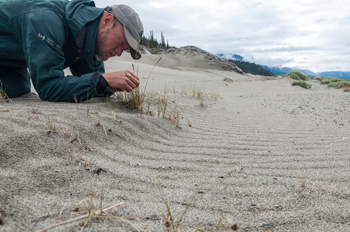
Alsek River
Kluane National Park and Reserve
The Alsek River is formed by the union of the Dezadeash and Kaskawulsh rivers in Kluane National Park and Reserve. From the confluence of these constituent rivers the Alsek flows southward for 250 km, breaching the Coast Mountains of British Columbia and Alaska before discharging into the Gulf of Alaska. The Alsek is a glacial river in its truest sense, from its broad glacially carved valley and braided upper reaches to its dynamic glacially-driven ever changing nature.
Dam glaciers

Nàłùdäy periodically surges impeding the flow of the Alsek.
Along its course, valley glaciers -- Nàłùdäy (Lowell Glacier), Tweedsmuir and Alsek glaciers – which occupy tributary valleys calve into the Alsek River. Periodically these glaciers have advanced or surged across the Alsek valley blocking the flow of the river and creating glacier dammed lakes.
Glacial Lake Alsek, impounded by Nàłùdäy (Lowell Glacier) was over 80 km long and the largest known glacier dammed lake in western North America since the retreat of the Cordilleran ice sheet. Old shorelines discernable high above the valley floor and possibly the population of Kokanee salmon in the Kathleen Lake watershed are the legacy of Glacial Lake Alsek.
Glacial Lake Alsek was not a one-time occurrence in the distant past. Rather it is a series of transient lakes, recurring over time. The most recent manifestation of Glacial Lake Alsek existed as recently as the early 1800s. It catastrophically drained around 1850 destroying everything in its path. Evidence of this event can be found in giant ripple marks on the valley floor and in the stories of local First Nations. While a complete blockage has not occurred since that event Nàłùdäy continues to periodically surge but is now only capable of causing partial blockages of the Alsek River because the ice has thinned considerably at its terminus.
Water poaching

It was here recently that the Kaskawulsh River captured the flow of the A'ay Chu (Slims River) diverting it into the Alsek watershed.
More recently the retreat of the Kaskawulsh Glacier, the source of the Kaskawulsh River, has resulted in much of the flow of 'Ä’äy Chù’ (Slims River), which flows into Kluane Lake to the north, being diverted down the Kaskawulsh increasing the volume of flow in the Alsek River. From our present day vantage point this seems to be a dramatic new development in the evolution of the landscape. The redirection of the Kaskawulsh Glacier’s meltwaters has in fact happened at this location in the past and it would be expected that flow down the 'Ä’äy Chù’ would be re-established if the Kaskawulsh Glacer were to re-advance across the valley. However, given the rate of human driven climate warming this is no longer expected to happen.
A similar event may now be about to unfold at the Alsek’s mouth where it discharges into the Gulf of Alaska. The retreat of the Grand Plateau Glacier, a result of the human induced warming climate, is creating the conditions whereby the mouth of the Alsek could be diverted into an adjacent valley. If this occurs, Dry Bay may no longer be a practical takeout for Alsek River rafters and it is unknown if the salmon which currently spawn in the Alsek will be able to find their way up the river to spawn.
Let it flow

Baikal sedge is listed as a Species of Special Concern in Canada.
The dynamic nature of the Alsek River has created a diversity of habitats strewn across its broad valley. Sand dunes, and glacial till, and braided river flats provide contrasting environments which support a diversity of vegetation types which in turn create oasis for a variety of wildlife from ground squirrels to grizzly bears to sockeye salmon.
As the climate warms in response to human activity and glaciers retreat as a result, the Alsek will continue to flow and respond to these environmental changes in dramatic and sometimes unpredictable ways.
Learn More
Alsek: A Canadian Heritage RiverRafting the Alsek
Related links
- Date modified :